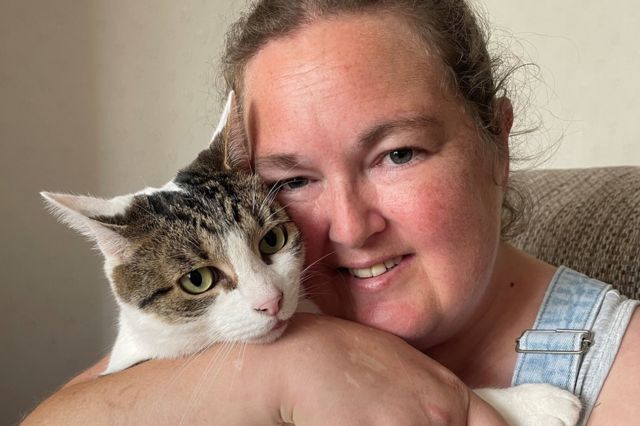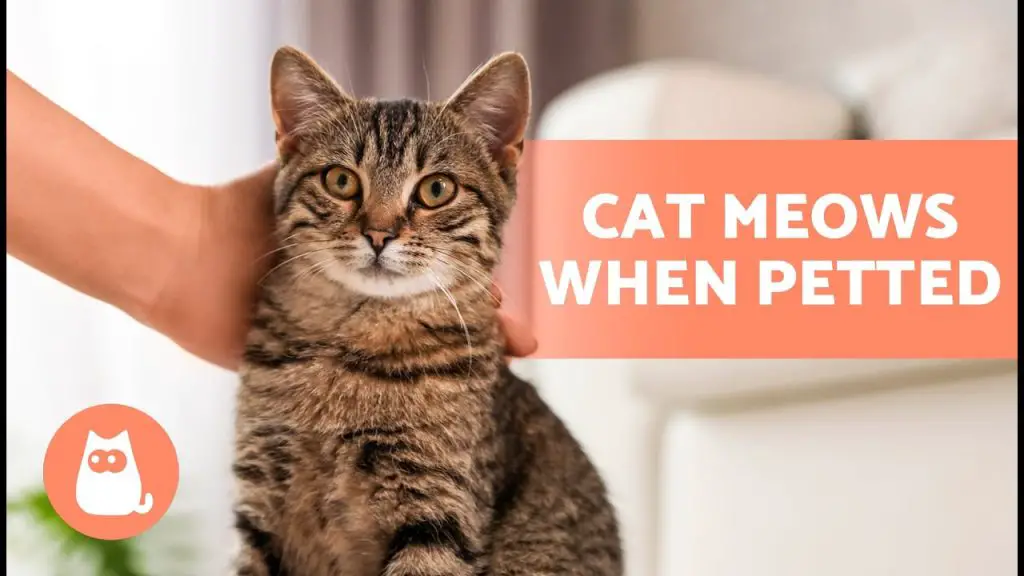When you pet your cat and she meows, it may be because she is enjoying the attention or trying to communicate with you. This behavior can be a sign of affection or a request for something like food or playtime.
Understanding your cat’s body language and vocal cues can help you interpret her meowing better and respond appropriately to her needs. Cats are lovable creatures known for their unique behaviors and ways of communicating. However, sometimes their meowing can leave their owners puzzled.
One common scenario is when a cat meows while being petted. This peculiar behavior can have various explanations, ranging from positive experiences to certain demands your feline friend might have. As a responsible cat owner, it is essential to decode your pet’s meowing to ensure their well-being and strengthen your bond. We will delve into the reasons behind a cat meowing when being petted and offer insights into interpreting their vocal cues effectively.
The Importance Of Understanding Your Cat’s Communication
Cats are unique creatures that communicate in various ways. One common behavior cats exhibit is meowing when being petted. This behavior can be attributed to a few different reasons. Firstly, some cats meow to signal their pleasure and comfort while being petted. This is a positive form of communication and shows that your cat is enjoying the attention. On the other hand, meowing can also indicate discomfort or overstimulation. Cats may meow to signal that they have had enough petting and want you to stop. Understanding your cat’s body language is crucial in deciphering what they are trying to communicate. Keep an eye out for signs such as flattened ears, a twitching tail, or dilated pupils, as these may indicate that your cat is feeling stressed or anxious. By observing and interpreting your cat’s body language while petting, you can ensure that your furry friend is comfortable and content.
Seeking Your Attention And Affection
My Cat Meowing When I Pet Her: Why Is It Happening? Cats have various ways of communicating and meowing is one of their primary vocalizations. When your cat meows while receiving petting, it is often indicative of a positive response. Through this vocalization, your feline companion is expressing contentment and enjoyment. It’s their way of letting you know that they are thoroughly enjoying the affectionate attention you are giving them. Cats may also meow while being petted to seek additional interaction with you, as a means of saying, “Don’t stop, keep going!” It can be seen as a form of encouragement to continue providing them with affection and attention.
If your cat meows when you pet her, it’s generally a positive and affectionate response. However, it’s important to observe your cat’s body language and overall behavior to determine if there are any underlying issues or discomfort. Remember, every cat is unique, and their meowing can have different meanings. Pay attention to your cat’s cues and enjoy the special bond you share.
Discomfort And Overstimulation
When it comes to cats meowing during petting, it could be a sign of discomfort or overstimulation. Cats have sensitivity to physical touch and pressure points, so it’s important to be aware of their boundaries. Some cats may not enjoy certain petting techniques or areas being touched, causing them to meow or become agitated. Areas to avoid include the base of the tail, belly, and paws, as these regions can be more sensitive for cats. If your cat meows when you pet her, try adjusting your petting technique or focus on areas she enjoys. Finding a gentle approach that your cat is comfortable with will help prevent meowing and promote a positive bonding experience.
Health Issues And Discomfort
Excessive meowing when petting your cat can indicate underlying health issues or discomfort. Physical pain or discomfort may lead to a vocalization response. It’s crucial to identify any potential health concerns associated with this behavior.
| Common health concerns |
|---|
| 1. Dental problems: Oral issues like tooth decay or gum disease can cause discomfort when touched. |
| 2. Arthritis: Joint inflammation can cause pain when pressure is applied, resulting in meowing. |
| 3. Hyperesthesia: Cats with this condition experience heightened sensitivity, leading to discomfort during petting. |
| 4. Urinary tract infections (UTIs): Infections in the urinary system can cause pain or discomfort, triggering meows. |
| 5. Skin conditions: Allergies, infections, or parasites can lead to itchiness or tenderness, provoking vocalization. |
It is essential to consult with a veterinarian to diagnose and address any potential health issues causing your cat’s meowing when petted. Identifying the root cause will help provide appropriate treatment and relieve your feline friend’s discomfort.
Anxiety And Stress Triggers
|
|
Misunderstandings And Misinterpretations
Understanding your cat’s vocalizations is essential for effective communication. Many cat owners may wonder why their feline companions meow when they’re being petted. This behavior can be easily misinterpreted, leading to confusion and misunderstandings. Cats may vocalize while being petted due to a variety of reasons, including discomfort, overstimulation, or even pleasure.
One common misunderstanding is associating meowing with contentment. While some cats may indeed purr and meow happily when being petted, others may vocalize to express their discomfort or request for the petting to stop. It’s important to pay attention to your cat’s body language and other cues, such as flattened ears or a swishing tail, which can indicate that they are not enjoying the physical contact.
Another misconception is assuming that all meowing means the same thing. Cats have a wide range of vocalizations, and each may have a different meaning. For instance, a short, high-pitched meow may indicate a greeting or a request for attention, while a low, drawn-out meow could signal dissatisfaction or hunger. By becoming familiar with your cat’s unique vocalizations and accompanying behavior, you’ll be better equipped to understand their needs and preferences.
| Misconception | Reality |
|---|---|
| Meowing always indicates contentment. | Cats may meow to express discomfort or request to stop petting. |
| All meowing means the same thing. | Cats have a wide range of vocalizations, each with a different meaning. |
By addressing these misconceptions and avoiding confusion, you can foster a better understanding and bond with your furry friend. Remember to pay attention to their body language, listen to their vocalizations, and respect their boundaries when it comes to petting. This will ensure that both you and your cat have a positive and harmonious experience together.
Reacting To Other Animals Or External Stimuli
The behavior of a cat meowing when being petted can be influenced by various factors, including reactivity to other animals or external stimuli. Some cats may become more vocal and meow when they are being petted due to the presence of other pets in the household or noises in the environment. To create a calm and distraction-free environment for your cat during petting sessions, consider the following:
| 1. Keep other pets away: | Separate your cat from other animals to reduce any potential reactivity or competition. |
| 2. Minimize external noises: | Choose a quiet and peaceful area for petting sessions, away from loud noises or distractions. |
| 3. Create a soothing atmosphere: | Dim the lights, play soft music, or use calming aromatherapy to help relax your cat during petting. |
| 4. Observe body language: | Pay attention to your cat’s body language and signals to ensure they are comfortable and enjoying the interaction. |
By providing a calm and distraction-free environment, you can help alleviate any stress or meowing your cat may exhibit during petting sessions.
Addressing The Meowing Behavior
Cats may meow when you pet them for a variety of reasons. It’s important to understand and manage this behavior to ensure your cat’s well-being.
1. Observe and analyze: Pay attention to the meowing behavior, noting any patterns, triggers, or changes in your cat’s body language. Is your cat meowing out of discomfort or anxiety?
2. Ensure physical comfort: Rule out any physical issues that could be causing your cat to meow when you pet them, such as pain or discomfort. Consult with a veterinarian if necessary.
3. Provide environmental enrichment: Cats may vocalize when they’re bored or understimulated. Ensure your cat has plenty of toys, scratching posts, and interactive playtime to keep them mentally and physically stimulated.
4. Positive reinforcement: Reward your cat with treats or praise when they exhibit calm behavior while being petted. This helps reinforce positive associations with petting and reduces meowing.
5. Seek professional assistance: If your cat’s meowing persists or intensifies despite your efforts, consult with a professional animal behaviorist or veterinarian for additional guidance and support.
Strengthening The Bond With Your Cat
When it comes to understanding your cat’s behavior, it’s important to recognize their vocal cues. If your cat meows when you pet her, it could be a form of communication and can have several possible meanings. It’s essential to build a strong bond with your cat to ensure effective and enjoyable interactions during petting sessions.
To develop trust and a harmonious relationship, try following these tips:
- Pay attention to your cat’s body language and meows. This can help you understand their needs and preferences.
- Start with gentle and slow petting. Allow your cat to guide you and indicate where they enjoy being touched.
- Offer treats and positive reinforcement during and after petting sessions. This helps create positive associations with physical touch.
- Respect your cat’s boundaries. If they show signs of discomfort or agitation, give them space.
- Provide regular playtime and mental stimulation to keep your cat happy and content.
By following these guidelines, you can strengthen the bond with your cat and create a positive and enjoyable experience during petting.

Credit: www.bbc.com
Conclusion
If your cat meows when you pet her, it could be indicative of various reasons, including pain, excitement, or simply wanting your attention. By observing your cat’s body language and considering other factors such as her overall health and behavior, you can better understand and address her needs.
Remember to provide a comfortable and safe environment for your feline friend and to consult with a veterinarian if you have any concerns. Happy petting!


